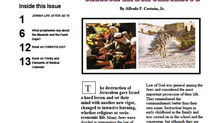“Eternal Waters: Unveiling the Mysteries of the Dead Sea Scriptures”
- Alfredo F. Cartano. Jr.
- Sep 14, 2023
- 3 min read
The Bible and the Dead Sea Scriptures are two profound collections of ancient religious texts that have shaped the course of human history and spirituality.
The Bible, known as the foundational scripture for the world’s largest religions, is a compilation of sacred writings that offer profound insights into the divine nature of existence, the nature of humanity, and the relationship between both. Divided into two main sections, the Old Testament and the New Testament, the Bible contains a rich tapestry of stories, teachings, and prophetic visions that explore themes of faith, morality, redemption, and ultimate truths. Its pages are filled with accounts of creation, the lives of prophets and spiritual leaders, guidance for righteous living, and the ultimate message of love, compassion, and salvation.
Complementing this spiritual masterpiece are the Dead Sea Scriptures, a collection of ancient Hebrew texts discovered in the mid-20th century near the Dead Sea. These scriptures offer a unique glimpse into the religious practices, beliefs, and traditions of the Essenes, a Jewish sect that flourished during the Second Temple period. Among these extraordinary writings are compositions such as the famous Dead Sea Scrolls, which contain previously unknown versions of biblical texts, psalms, and other religious texts, shedding new light on the authenticity and transmission of ancient scripture.
Together, the Bible and the Dead Sea Scriptures provide an unparalleled insight into the roots of human spirituality and moral foundations. They not only serve as timeless guides for personal introspection, ethical living, and spiritual growth but also invite us to explore the eternal questions of existence, moral responsibility, and our place in the cosmos. The wisdom contained within these sacred writings continues to inspire and resonate with individuals of diverse cultures and backgrounds, making them an indispensable beacon of light and knowledge for all seekers of truth and meaning.
How the Dead Sea Scriptures help the Bible understanding:
1: The Dead Sea Scriptures Provide Historical Context. The Dead Sea Scrolls, discovered in the mid-20th century, provide a glimpse into the Jewish community of the Second Temple period. These scrolls shed light on the historical and cultural context of the Bible, allowing a better understanding of the biblical texts. For example, the scrolls contain copies of many Old Testament books, and their comparison with later versions helps scholars trace the development and transmission of biblical texts. This historical context enhances our understanding of the people, events, and beliefs that shaped biblical narratives, offering valuable insights into the Bible’s interpretation.
2: The Dead Sea Scriptures Reveal Variant Texts. The Dead Sea Scrolls contain alternative or variant readings of familiar biblical texts from the Old Testament. These variants illuminate discrepancies and variations that have occurred over time due to copying errors, translation issues, or possibly intentional alterations. By comparing the Hebrew Bible we have today with the Dead Sea Scrolls, scholars can identify these variants, helping us better understand the transmission and evolution of biblical texts. This analysis also deepens our appreciation for the meticulous preservation efforts made by scribes and translators throughout history.
3: The Dead Sea Scriptures Reveal Additional Texts. In addition to biblical texts, the Dead Sea Scrolls include many Jewish writings from the Second Temple period that were not included in the Bible, such as the Book of Enoch, Jubilees, and the War Scroll. These texts offer valuable insights into Jewish beliefs, practices, and worldview during the time when the biblical texts were being written. By examining these additional texts, one gains a broader understanding of the diverse religious landscape that influenced the development of the biblical canon.
4: The Dead Sea Scriptures Provide Biblical Commentaries. Among the Dead Sea Scrolls are numerous commentaries on biblical passages, known as pesharim. These commentaries offer interpretations, explanations, and theological reflections on biblical texts, shedding light on how the ancient Jewish community understood and applied the Bible. By studying the pesharim, scholars gain valuable insights into the interpretive traditions and exegetical methods used by Jewish communities during the Second Temple period.
5: The Dead Sea Scriptures Present Apocalyptic Literature. One significant genre found among the Dead Sea Scrolls is apocalyptic literature, which often deals with end-of-world scenarios, heavenly visions, and hidden knowledge. This genre helps us understand the apocalyptic worldview prevalent during the Second Temple period and sheds light on concepts and symbols used in the Bible, particularly in the Book of Revelation. By analyzing apocalyptic texts such as the War Scroll and the Book of Giants, we gain a deeper understanding of the symbolic language and eschatological themes present in the biblical prophetic books. Such insights enrich our interpretation of biblical passages dealing with the future and the divine plan for humanity.































Comments